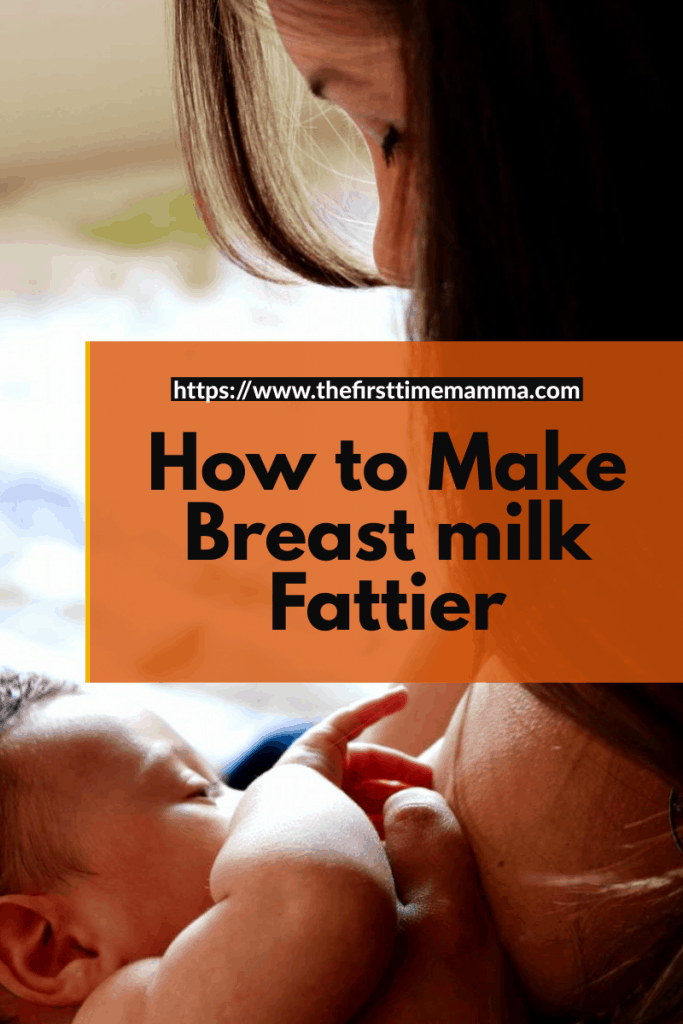It is every mother’s top priority to make sure that her baby is getting the appropriate amount of nutrients important for their healthy growth and development. Since we can’t measure how much milk the baby has had from the breast (although that would be quite convenient) that’s why most breastfeeding mothers are in self-doubt over whether or not their baby is getting enough food. Moms often think their breast milk isn’t nutritious enough, which makes them wonder is there any way to increase the fat content of the breast milk? To answer this question, yes. In fact, there are several ways in which you can increase the fat content of your milk. Below is how to make Breastmilk fattier.
Hey! By the way… any links on this page that lead to products on Amazon are affiliate links and I earn a commission if you make a purchase. Thanks in advance – I really appreciate it! .
6 Ways to Make Breastmilk Fattier
Look for how to get fattier breast milk? Yes, it is possible. Below are 6 tested and proven ways to produce fattier breast milk.
- Increase the quantity of unsaturated fats in your diet: The first way to get fattier breastmilk is to take more unsaturated fats in your diet. Whatever diet you consume, determines the quality of your breastmilk and its production. So, your baby gets what you eat. With that fact in place, it would make sense to consume healthier fats or unsaturated fats to make your breastmilk fattier. Foods to make breast milk fattier should contain unsaturated fats that include; nuts, eggs, salmon, avocado, and olive oil. These fats help lower cholesterol and lower the risk of heart disease. They also help improve blood sugar control so it’s a win-win situation for both mother and baby. Though these fats are healthy, consume them in a balanced manner to avoid indigestion.
- Let your baby empty one breast first before offering the other breast: Many women believe that they need to feed on both sides at each feeding. This is not always the case. As milk is produced, fat contents in the milk stick to each other and the walls of milk ducts. The milk then gradually moves towards the nipple as the breasts fill up with milk, bringing the thin watery stuff (foremilk) forward while leaving the denser and fattier hindmilk behind (because it sticks to the walls of the ducts). Switching baby from one breast to another while they are still sucking actively means that they aren’t getting enough time to reach the hindmilk that helps them pack on the pounds. So, to make breastmilk fattier, let baby drain one breast and if they are still hungry, then offer them the other one. Some mothers pump out the foremilk and only let the baby consume hindmilk. This isn’t the right way to make sure your baby gets all the fat they need. Though hindmilk is most recommended, yet it doesn’t rule out the fact that your baby still largely needs the foremilk. Though it lacks fat content, it is very rich in proteins and carbohydrates essential for the growth of your baby. So, make sure that your baby takes in this milk too.
- Nurse frequently with shorter intervals: To increase fat in your breast milk, you need to reduce the time interval between feedings. This is important because by reducing these time intervals you ensure that your baby is getting the hindmilk which is richer in fats. Unlike when the feeding time intervals are quite spaced and the body will have produced more foremilk and chances are if your baby feeds less often your baby might not get to the much-needed hind milk. According to research, evening milk is fattier than milk produced in the morning. As a mother, you must feed your baby more in the evening so you can increase the consumption of these fats.
- Breast compressions help you make your breast milk fattier. Breast compressions is a tactic that helps you to produce fattier breastmilk. It’s simple to do when your baby feeds; slightly hold your breast from the top forming a C shape and apply a little pressure. Do this and only stop when your baby stops to catch their breath. Repeat it when the baby resumes feeding. Breast compression allows the fat content stored in your mammary glands to move down towards the ducts quickly, and as a result, the fattier hind milk arrives sooner.
- Increasing your protein intake can help increase your milk supply overall, and more milk means more fat for your baby. This is another way to make your breast milk fattier. Foods that have high protein content include; lean meats, chicken, fish, eggs, dairy, nuts, and seeds. However, if you are a vegetarian or you do not get enough protein from your food alone, consider adding a protein supplement to your diet.
- Certain supplements can help you increase your milk supply, and some can potentially increase the fat content. Do you know there are supplements to make breastmilk fattier? Supplements can make breast milk fattier. One of the most popular supplements known to increase fat content in breast milk is Sunflower Lecithin. It is usually used by mothers who frequently experience blocked ducts and thus can’t find any relief with breast compression or massage. This supplement works by decreasing the viscosity of breast milk by mixing the fatty parts of breast milk with the watery parts making it more “slippery.” Many mothers believe that this could also help their baby get more fat-rich hindmilk quickly at the beginning of the feeding, which increases the percentage of fatty acids present in the milk. Be sure to consult with your doctor first before starting any supplements.
FAQS
When is breastmilk fattier?
The more the baby sucks the breast through the day or the more you pump, the fattier the breast milk becomes. So, naturally, breast milk becomes fattiest in the evening.
Does breast milk get fattier as the baby grows?
Yes, breast milk gets fattier as the baby grows. A study by Pediatrics Digest revealed that breastmilk gets fattier after the first year.
Is fatty breast milk good or bad?
Fatty breast milk is good for babies because it helps them to gain weight.
Does breast milk composition change as the baby gets older?
Yes. Breast milk composition changes as the baby get older. This helps to meet the baby’s nutritional requirements for proper growth.
Conclusion
These tips are known to help mothers make breastmilk fattier and make sure that their baby is getting all the nutrients they need to grow healthily. Keep in mind that the fat content in milk is released when the breast is nearly empty. So, be sure to breastfeed and pump more often and let your baby finish feeding from one breast first before offering the other one.
One important take on this issue is using foods to make breast milk fattier. Foods you can increase in your diet include unsaturated fats such as nuts, eggs, salmon, avocado, and olive oil, and proteins. Even if after trying all these tips, you don’t see any change in the fat content of your milk then don’t be discouraged. Just know that breast is best. Therefore, even some breast milk is better than none. Just go with the flow and do what you think is best for you and your baby.
Check out the Ultimate Breastfeeding class to become a pro at breastfeeding within 90 minutes!


